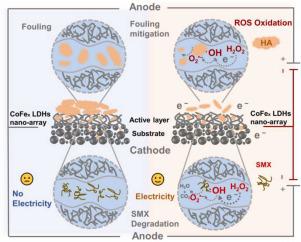当前位置:
X-MOL 学术
›
J. Hazard. Mater.
›
论文详情
Our official English website, www.x-mol.net, welcomes your feedback! (Note: you will need to create a separate account there.)
Rational design of a hydrophilic nanoarray-structured electro-Fenton membrane for antibiotics removal and fouling mitigation: An intensified catalysis process in an oxygen vacancy‐mediated cathodic microreactor
Journal of Hazardous Materials ( IF 13.6 ) Pub Date : 2024-04-04 , DOI: 10.1016/j.jhazmat.2024.134138 Liu Yang , Jing Zhao , Daliang Xu , Xinsheng Luo , Yonghui Han , Xiaobin Tang , Heng Liang
Journal of Hazardous Materials ( IF 13.6 ) Pub Date : 2024-04-04 , DOI: 10.1016/j.jhazmat.2024.134138 Liu Yang , Jing Zhao , Daliang Xu , Xinsheng Luo , Yonghui Han , Xiaobin Tang , Heng Liang

|
Electro-Fenton membranes (EFMs) can synchronously realize organic micropollutants destruction and fouling mitigation in a single filtration process with the assistance of hydroxyl radicals (•OH). Herein, a nanoarray-structured EFM (NS-EFM) was designed by assembling Fenton reactive CoFe-LDH nanowires using a low-temperature hydrothermal method. Combined with a defect-engineering strategy, the oxygen vacancies (O) in the CoFe-LDH nanoarrays were tailored by manipulating the stoichiometry of cations to optimize the Fenton reactivity of NS-EFMs. The optimized NS-EFM demonstrated exceptional sulfamethoxazole (SMX) removal (99.4%) and fast degradation kinetics (0.0846 min), but lower energy consumption (0.22 kWh m per log removal of SMX). In-depth mechanism analysis revealed that the intrinsic electronic properties of O endowed NS-EFM with enhanced reactivity and charge transferability at metallic active sites of CoFe-LDH, thereby intensifying •OH generation. Besides, the nanoarray-structured NS-EFM built a confined microreactor space, leading to expedited •OH microflow to SMX. Meanwhile, the hydrophilic nature of CoFe-LDH nanoarrays synergistically contributed to the high flux recovery (95.0%) and minimal irreversible membrane fouling (5.0%), effectively alleviating membrane fouling within pores and on surfaces. This study offers insights into the potential of defect engineering as a foundational strategy in the design of EFMs, significantly advancing the treatment of organic pollutants and control of membrane fouling.
中文翻译:

用于去除抗生素和减轻污垢的亲水性纳米阵列结构电芬顿膜的合理设计:氧空位介导的阴极微反应器中的强化催化过程
电芬顿膜(EFM)可以在羟基自由基(·OH)的辅助下,在一次过滤过程中同步实现有机微污染物的破坏和污染的缓解。在此,通过使用低温水热方法组装芬顿反应CoFe-LDH纳米线,设计了纳米阵列结构的EFM(NS-EFM)。结合缺陷工程策略,通过控制阳离子的化学计量来定制 CoFe-LDH 纳米阵列中的氧空位 (O),以优化 NS-EFM 的芬顿反应性。优化的 NS-EFM 表现出出色的磺胺甲恶唑 (SMX) 去除率 (99.4%) 和快速降解动力学 (0.0846 分钟),但能耗较低(每去除 SMX 对数 0.22 kWh m)。深入的机理分析表明,O的固有电子特性赋予NS-EFM增强了CoFe-LDH金属活性位点的反应活性和电荷可转移性,从而强化了·OH的生成。此外,纳米阵列结构的NS-EFM构建了一个有限的微反应器空间,导致•OH微流加速至SMX。同时,CoFe-LDH纳米阵列的亲水性协同促进了高通量恢复(95.0%)和最小的不可逆膜污染(5.0%),有效减轻了孔内和表面的膜污染。这项研究深入探讨了缺陷工程作为 EFM 设计的基本策略的潜力,显着推进了有机污染物的处理和膜污染的控制。
更新日期:2024-04-04
中文翻译:

用于去除抗生素和减轻污垢的亲水性纳米阵列结构电芬顿膜的合理设计:氧空位介导的阴极微反应器中的强化催化过程
电芬顿膜(EFM)可以在羟基自由基(·OH)的辅助下,在一次过滤过程中同步实现有机微污染物的破坏和污染的缓解。在此,通过使用低温水热方法组装芬顿反应CoFe-LDH纳米线,设计了纳米阵列结构的EFM(NS-EFM)。结合缺陷工程策略,通过控制阳离子的化学计量来定制 CoFe-LDH 纳米阵列中的氧空位 (O),以优化 NS-EFM 的芬顿反应性。优化的 NS-EFM 表现出出色的磺胺甲恶唑 (SMX) 去除率 (99.4%) 和快速降解动力学 (0.0846 分钟),但能耗较低(每去除 SMX 对数 0.22 kWh m)。深入的机理分析表明,O的固有电子特性赋予NS-EFM增强了CoFe-LDH金属活性位点的反应活性和电荷可转移性,从而强化了·OH的生成。此外,纳米阵列结构的NS-EFM构建了一个有限的微反应器空间,导致•OH微流加速至SMX。同时,CoFe-LDH纳米阵列的亲水性协同促进了高通量恢复(95.0%)和最小的不可逆膜污染(5.0%),有效减轻了孔内和表面的膜污染。这项研究深入探讨了缺陷工程作为 EFM 设计的基本策略的潜力,显着推进了有机污染物的处理和膜污染的控制。



























 京公网安备 11010802027423号
京公网安备 11010802027423号